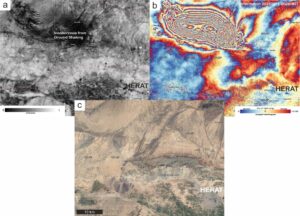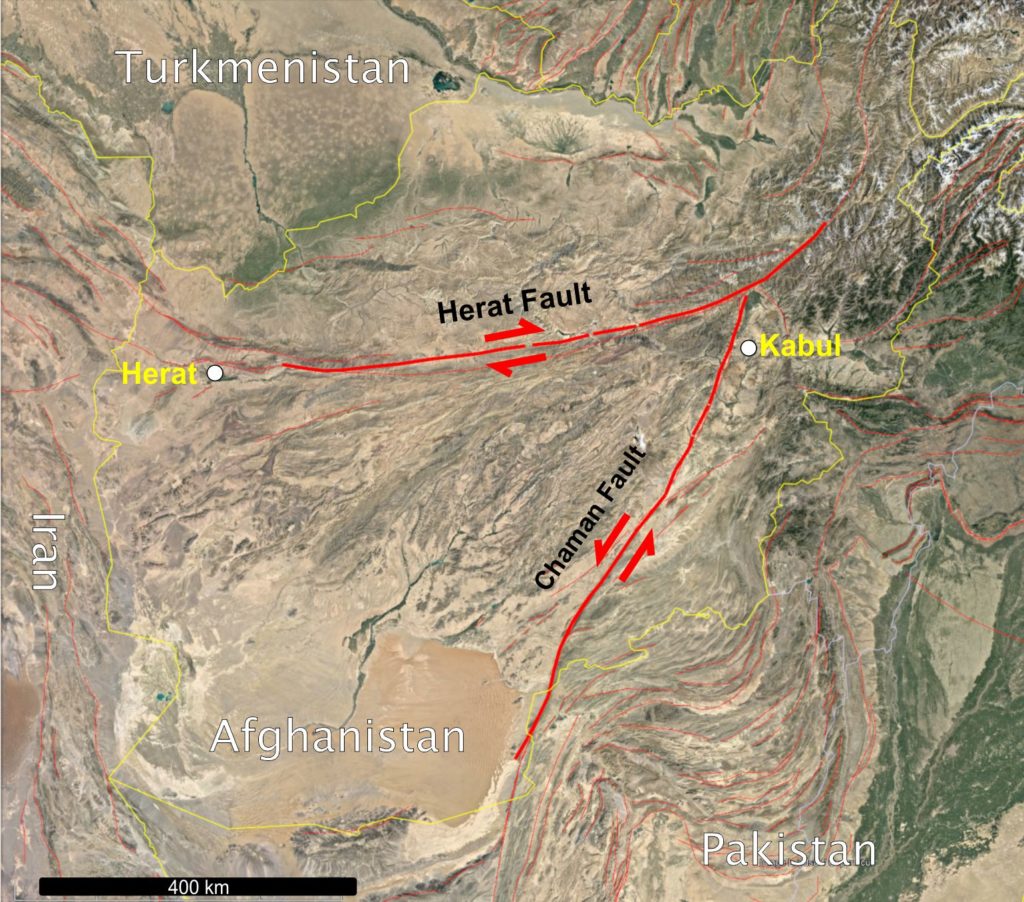Crustal Deformation and Active Tectonics of Afghanistan
This exciting project aims to advance our understanding of active crustal deformation and continental tectonics for the region of Afghanistan using high-resolution satellite radar (SAR) interferometry. We aim to quantify the rates of faulting and distribution of crustal strain using the latest earth observation data and machine learning techniques across this entire region. This is important for understanding the deformation of continents, growth of mountains and distribution of seismic hazard.
As demonstrated in recent devastating earthquakes in the north-west of the country (Figure 1) which killed thousands of people, Afghanistan experiences large earthquakes due to being caught up in the tectonic plate collision into Eurasia of both Arabia and India. This results in widespread continental deformation and active faulting that leads to seismicity, and sometimes damaging earthquakes such as in 2023 and 2022 (https://temblor.net/earthquake-insights/multiple-factors-make-afghan-communities-vulnerable-to-earthquakes-14301/).

This project will use space-based SAR instruments (Elliott et al, 2016) and develop quantitative methodologies to assess active tectonic rates of deformation associated with the major continental strike-slip faults within Afghanistan and its surroundings. There are varied active tectonic processes across the region: rapid slip on the Chaman fault in the east accommodates the plate boundary motion between Eurasia and India; Fold-and-thrust deformation in the Afghan-Tajik depression in the north of the country is related to westward collapse of the Pamir plateau; distributed strike-slip and reverse faulting within Afghanistan, including the Herat fault, is likely to result from interactions between the Arabian and Indian indenters, and from the topographic contrast between the highlands of the Hindu Kush and Pamir, and adjacent lowland basins. Determining the rate and distribution of deformation across these broad collisional zones is especially important for understanding the tectonics of these areas and the role they play in accommodating the overall convergence of the India-Eurasia collision zone. In this project we will assess the relative slip rates and along-strike variability across the Herat and Chaman fault zones as they pass through Afghanistan as well as the distribution of strain across the entire country. In addition to constraining the tectonics of the region, our observations will help in the assessment of the seismic hazard for the region (Boyd et al., 2007). The country has large populations close to these faults, such as the capital Kabul (current population ~4.3 million, having doubled in the past 25 years), which is exposed to a large shaking hazard and has had several major large earthquakes occur in the region in the past (Ambraseys & Bilham 2003).

ObjectivesIn this project, the student will apply the latest techniques in measuring active tectonics, faulting, continental deformation, and seismic hazard. The project will have the following specific objectives:
- The postgraduate researcher will generate high-resolution interferometric synthetic aperture radar (InSAR) satellite data from Sentinel-1 over the whole country of Afghanistan (Lazecky et al., 2020), focusing initially on the strike-slip zones crossing the country of Afghanistan.
- They will then generate dense time series of deformation (Morishita et al., 2020) across these major strike slip fault zones to quantify the rates of slip, the presence/absence of creeping zones and determine the extent of distributed deformation and thrusting across them. It will be necessary to account for any seasonal signal noise that will mask these rates as well as implementing atmospheric noise corrections. They will apply the latest deep learning techniques (Rouet-Leduc et al, preprint) to extract subtle deformation signals from this noise.
- From this data, they will then model the large-scale regional deformation on the bounding fault structures based initially upon the GEM Global Active Faults Database (Styron & Pagani, 2020), and building their own detailed observations from optical satellite imagery and digital topography as required. They will use block modelling approaches to identify the key active structures responsible for controlling the distribution of strain. More complicated Finite Element Modelling will be undertaken in areas where distributed strain warrants this.
- Depending on the interests of the researcher, they will subsequently apply this approach to other research questions. This may include measuring the folding and faulting in the northern region of the country (McNab et al, 2020) to quantify rates of uplift and subsidence associated with these structures or focusing in on the assessment of seismic hazard and risk to the major population centres within Afghanistan (Pagani et al, 2018).
The balance between these components will vary depending on the specific interests of the student.
Training
The student will work under the supervision of Dr John Elliott, within the Active Tectonics group of the Institute of Geophysics & Tectonics in the School of Earth & Environment at Leeds which comprises a large number of postgraduate researchers and postdocs. The project will be co-supervised by Prof. Andy (also in IGT, SEE), Prof Richard Walker (University of Oxford) and Dr Richard Styron (Global Earthquake Model Foundation). The Institute of Geophysics & Tectonics also hosts the Centre for the Observation and Modelling of Earthquakes, Volcanoes and Tectonics (COMET, http://comet.nerc.ac.uk/) which provides a large group of researchers engaged in active tectonics research with whom the student can interact. The successful PhD student will have access to a broad spectrum of training workshops that include an extensive range from scientific computing through to managing your degree, and preparing for your viva (http://www.emeskillstraining.leeds.ac.uk/). The student will also have the opportunity to engage with a wider range of scientists within COMET at a number of other UK institutions who have a broad interest in problems of active tectonics. Additionally opportunities may arise for fieldwork across Central Asia in support of the Earthquakes in Central Asia program (http://quakesincentralasia.org/).
Student profile
The student should have a strong interest in remote sensing, active tectonics problems, and a strong background in a quantitative science (earth sciences, geophysics, geology, physics, natural sciences) with a competent background in the use of mathematics within the physical sciences. Ability to work with programming languages (such as Python or Matlab) as well as within a GIS framework and experience of large datasets (such as Earth Observation imagery) would be useful, as well as a willingness to engage with implementation of machine learning algorithms and high performance computing.
References
Ambraseys, N., & Bilham, R. (2003)
Earthquakes in Afghanistan. Seismological Research Letters, 74(2), 107-123, doi:10.1785/gssrl.74.2.107
Boyd, O. S., Mueller, C. S., & Rukstales, K. S. (2007)
Preliminary earthquake hazard map of Afghanistan. US Geological Survey Open-File Report, 2007, 1137. https://pubs.usgs.gov/of/2007/1137/
Elliott, J. R., R. J. Walters & T. J. Wright (2016)
The role of space-based observation in understanding and responding to active tectonics and earthquakes, Nature Communications, 7, doi:10.1038/ncomms13844.
Lazecký, M., Spaans, K., González, P.J., Maghsoudi, Y., Morishita, Y., Albino, F., Elliott, J., Greenall, N., Hatton, E., Hooper, A., Juncu, D., McDougall., A., Walters, R. J., Watson, C. S., Weiss, J. & Wright, T. J. (2020)
LiCSAR: An automatic InSAR tool for measuring and monitoring tectonic and volcanic activity. Remote Sensing, 12(15), p.2430, doi:10.3390/rs12152430.
McNab, F., Sloan, R. A., & Walker, R. T. (2019)
Simultaneous orthogonal shortening in the Afghan-Tajik Depression. Geology, 47(9), 862-866, doi:10.1130/G46090.1
Morishita, Y., Lazecky, M., Wright, T.J., Weiss, J.R., Elliott, J.R. and Hooper, A. (2020)
LiCSBAS: An Open-Source InSAR Time Series Analysis Package Integrated with the LiCSAR Automated Sentinel-1 InSAR Processor. Remote Sensing, 12(3), p.424, doi:10.3390/rs12030424.
Pagani, M., Garcia-Pelaez, J., Gee, R., Johnson, K., Poggi, V., Styron, R., Weatherill, G., Simionato, M., Viganò, D., Danciu, L. & Monelli, D. (2018)
Global Earthquake Model (GEM) Seismic Hazard Map (version 2018.1–December 2018). doi:10.13117/GEM-GLOBAL-SEISMIC-HAZARD-MAP-2018.1
Rouet-Leduc, B., Jolivet, R., Dalaison, M., Johnson, P. A., & Hulbert, C. (2020)
Autonomous extraction of millimeter-scale deformation in InSAR time series using deep learning. Nat Commun 12, 6480 (2021). https://doi.org/10.1038/s41467-021-26254-3
Styron, R., & Pagani, M. (2020)
The GEM global active faults database. Earthquake Spectra, 36(1_suppl), 160-180, doi:10.1177/8755293020944182
